Whale Alley - an ancient Eskimo sanctuary on the island of Itygran, an archaeological complex that represents two rows dug into the soil of the huge bones of bowhead whales.
The complex was opened in 1976 by a group of researchers from the Institute of Ethnography of the USSR Academy of Sciences under the guidance of M. A. Chlenov.
Considered one of the wonders of Russia!
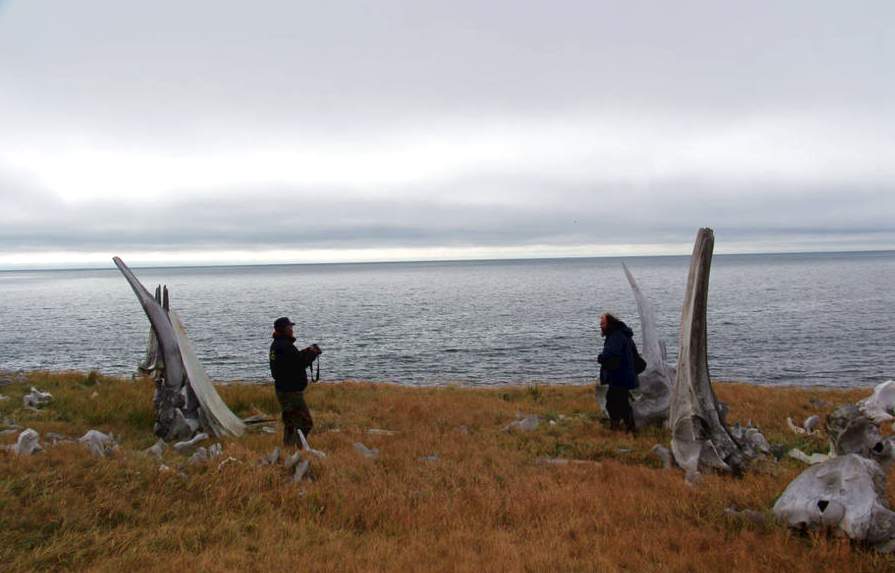
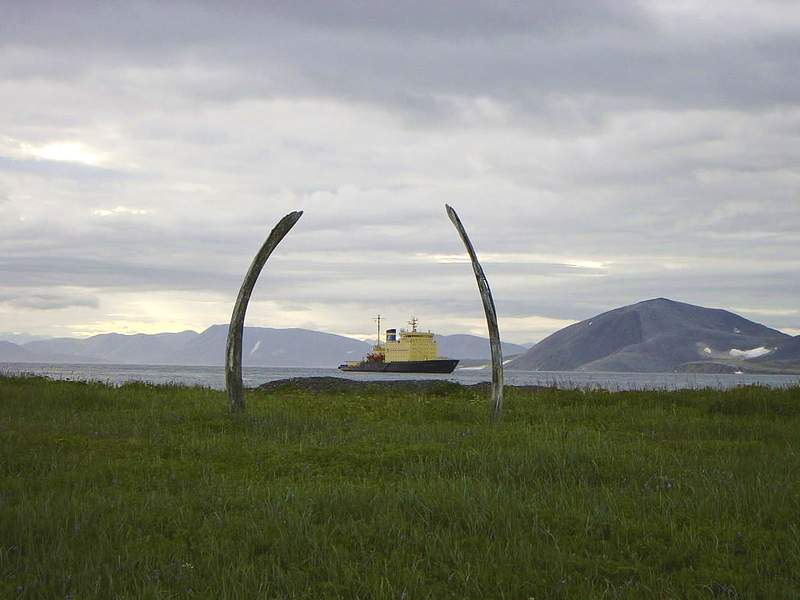
Whale alley is one of the most famous, but until recently no one knew anything about it. The unique archaeological complex is located to the northeast of Providence Bay, in the Bering Strait, on the island of Yttygran. According to scientists, the Whale Alley is considered a miracle not only from a scientific, but also an archaeological point of view.
The bay, on the bank of which the monument is located, is surrounded from the north-east and south-west by steep rocky protrusions, but between them the hills fall somewhat and form a relatively gentle slope covered with various tundra vegetation. On this green background, groups of seemingly bright white pillars of whale jaws clearly stand out, and as they approach the shore, the bizarre outlines of whale skulls dug into the pebbles by a narrow bow are visible above the grassy edge of the beach.
In the space between the rows of skulls and jaw bones of the bowhead whale, there are stores for products — meat pits — and artificial structures in the form of rings lined with stone. At the end of the complex, a man-made stone road 50 meters long was preserved on the hillside. The road leads to a flat, round area. The site is surrounded on all sides by boulders. In the center of it also lies a large flat boulder, and not far from it there is a hearth made of small stones, filled with ash.
It is not only the size of the monument that amazes the imagination (its total length is 500 meters!), But also the structure of the architectural complex. Whale alley is unique in the truest sense of the word. The scale of the Whale Alley, the nature of the buildings erected on it indicate that it most likely was the central sanctuary for the inhabitants of numerous Eskimo villages that existed in antiquity in the south-east - from Cape Chaplin to Mechigmensky Bay. It is possible that the inhabitants of the US St. Lawrence Island also came here.
The rituals performed on the Whale Avenue were, in all likelihood, of two types. In some rituals everyone who arrived on the island could participate, in others only elders and shamans could participate. Judging by the way religious objects are located on Ytytgrana, only selected ones, “initiates,” had the right to climb the stone road to the hearth and the sacrificial stone and perform a ritual near them, which was the culmination of the festival.
![]()
ISLAND ISYGRAN
Itygran (Ytytgran, Ittygran) - an island in the Senyavin Strait of the Bering Sea, within the Providensky District
Located north of Cape Chukotka, at the southeastern tip of the Chukotka Peninsula, 1.5 km from the mainland coast and 3.8 km from Arakamchechen Island. The area is 55 km². The island extends 13.5 km in length with a maximum width of 5 km.
The highest point is Mount Itygran with a height of 545 m. The island has two small lakes - the Middle and Kamalik.
The name is translated from Chuk. Ignran "wolf lair", with Eskim. Siklyuk "meat pit". There is another version of the origin of the toponym - from Chuk. Etgyran "home halfway." This is due to the fact that when hunting dogs or canoes from Chaplino to Yanrakynot, hunters always stopped for a break on the island, where there was a good hunt for a sea animal and meat stocks were always arranged here.
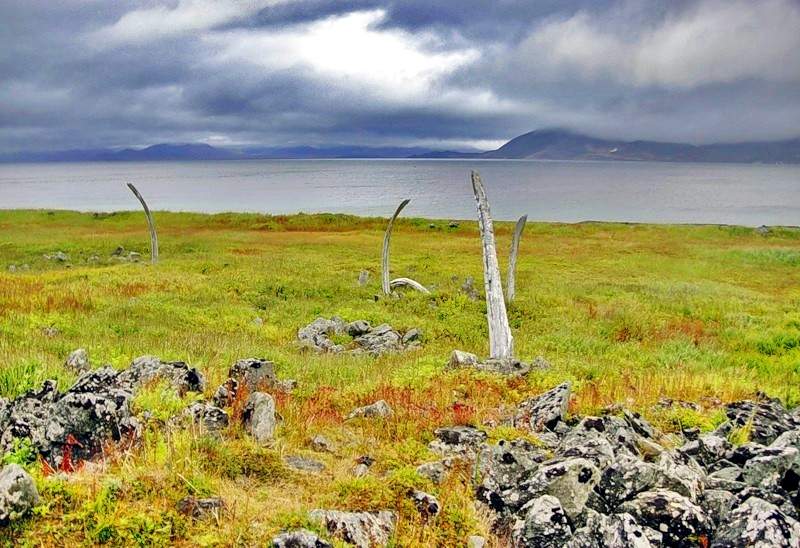
The island of Itygran was discovered and described during the expedition of F.P. Litke in August 1828.
On the island until the early 1940s. there was an Eskimo settlement Siklyuk.
On rocky promontories along the perimeter of the island there are colonies of seabirds with a total of up to 10 thousand pairs, in the colonies they nest - Bering cormorant, large white-headed gulls, moevka, murreus, Pacific Chistik, ipatka and ax.
An endemic grows on the island - senyavinskaya wormwood (artemisia senjavinensis), listed in the Red Book of Russia.
The island is famous for the Whale Alley - an ancient Eskimo structure of parallel rows of skulls and jaws of bowhead whales dug into the ground. Whale Alley was built from 50-60 skulls and 30 jaws and hundreds of specially laid stones. Dated to the period of the late Punuk (XIV-XVI centuries. AD.).
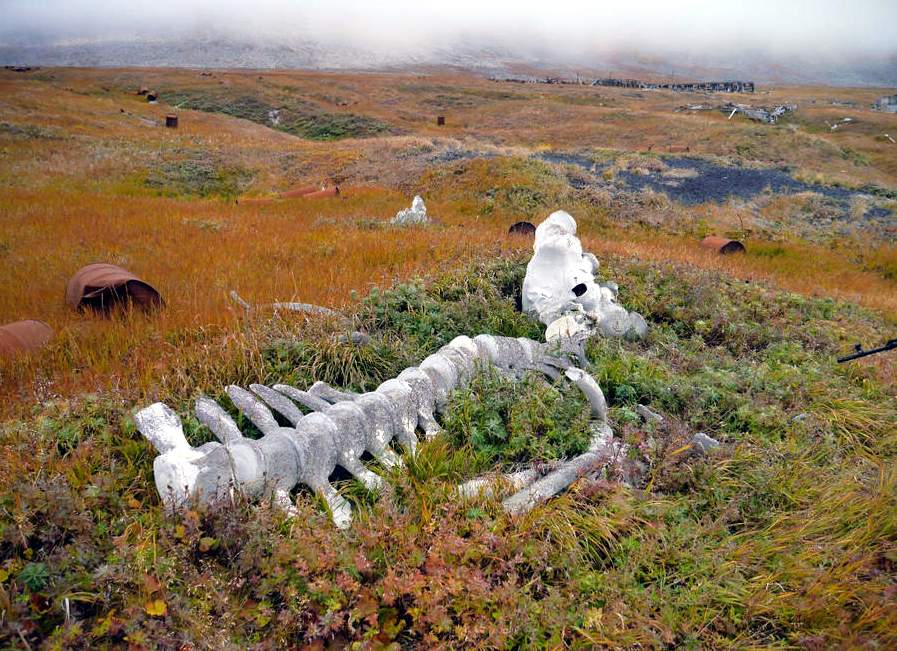
ARTICLE ABOUT KITTLE ALLEY (AROUND THE WORLD)
The end of the XIV century, the end of summer, the end of a long northern day ... And from the north and from the south, fourteen canoes go to the shore along a light ripple of the bay. They are large, but in the place of the rowers, usually grassroots congregationists, the most distinguished hunters of fourteen villages are sitting now - only those who are familiar with the secrets of the union of warriors are allowed to the annual feast at the shrine, others do not even have the right to know where it is located.
On all the tops of the surrounding coast there are pillars of whale jawbone - the landmarks of the sea roads. From the place in the sea where the gates of these landmarks converge, white rocks are visible. And the initiate knows - it is necessary to rule on them from here ...
Such a picture was drawn to us throughout the long “desk” winter - after the 1976 field season. It was drawn as a hunch: we only had hastily taken photos, a flat copy of the magnificence that was revealed to us in the Silyuk Bay of the small, deserted Chukchi island of Yttygran. It was surprisingly lucky for us then - there were sun and wind, literally for several hours, the fog was dispersed, as if specially for that, so that our carbas would not pass by again. Five years ago, an expedition of the Institute of Ethnography of the Academy of Sciences of the USSR inspected the remains of an ancient Eskimo village and its necropolis on this island, but the autumn fog drizzling incessant rain kept hiding only two hundred meters away ... pebbles! He hid something that none of those who are engaged in the history of Eskimo culture saw.
The culture of the Eskimos in the form in which the Europeans met it and were able to study ethnographers was a very controversial phenomenon: a number of features that seemed to be directly inherited from the Paleolithic - and extremely complex technique of sea hunting and navigation, a highly developed religious and mythological representation, complex etiquette of relationships between people - and at the same time, an extremely simplified social structure, practically no remnants of a tribal organization. Many scientists believed that such an organization in the past could not exist, but disappeared as a result of the small size and disunity of human groups in the Arctic. But when and where it existed, what forms it took - about all this until recently almost nothing! was not known. The archaeological study of Eskimo culture began relatively recently - and again a tangle of contradictions. The remnants of the ancient Eskimo settlements in most of the American Arctic testified: this culture was not much different from what ethnographers of the late XIX - early XX century observed. But the ancient cultures of Bering Sea, as it turned out, had a completely different look.
As a result of the excavation, it became clear that in Ancient Bering Sea society there were quite sharp not only property, but also social, class differences, which even allowed us to assume the beginning of the formation of a class society. But was it possible that something similar was possible in the Eskimo society, which lived solely on sea hunt and gathering?
According to ethnography, it was believed that no. It seemed unquestionable that sea hunters, at least before the appearance of firearms, had difficulty in providing themselves with food, often on the verge of disastrous hunger strikes. After all, the Eskimos lived exactly on the verge of starvation when the ethnographers began to study them. And therefore it was believed that it was always so. But it turned out that the climate here in the VIII to XIV century was much warmer than it is now, and the natural fishing conditions were much more favorable. And precisely at this time, as the data of archeology show, the Eskimo settlements become much larger than before, whaling becomes especially developed.
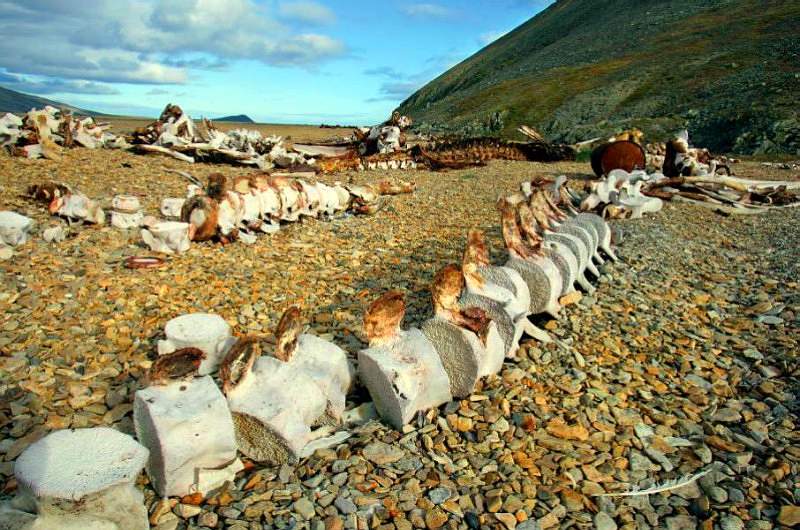
So, the natural conditions of the VIII — XIV centuries allowed even on the basis of a hunting, purely appropriating economy to receive a solid surplus product - the basis of the basis of any complication. social organization. And archaeological data seems to show that it really took place.
But again a contradiction. After all, the ancient Eskimo villages, even in the most favorable times, did not have more than 100–200 people: This is not enough for the emergence of a complex social structure.
Theoretically, such a contradiction can be removed by the assumption that there were some kind of associations, alliances - military, hunting - between such small villages. Like, for example, American Indians, ..
But unlike the Indians, who had well-defined tribes, with their specific territory, with some tribal and even tribal, embracing unions of several tribes with power in the person of leaders, councils of elders, the concept of the tribe looked rather vague among the Eskimos. and, in any case, the ethnographers did not see any common tribal or especially intertribal authorities.
There were absolutely no archaeological "signs" of the existence of alliances in the past ... Until they opened for a few hours on the pre-departure day of the expedition of the 76th year, the bone pillars on the coast of the Yttygran island. But only as a “sign”, a reason for imagination - until the next field season, when the expedition began a detailed study of the monument.
They stood for nearly half a kilometer along the coast, singly, in groups of two, in whole clusters - several dozen huge, more than five meters high, jaw bones of bowhead whales. On the tops of their visible notches and holes, obviously, for tying some objects.
True, the pillars of whale jaws are quite common for the old Eskimo villages, since both the walls of the dugouts and canoes for storing canoes and drying for meat were kept on them, but in these cases they do not exceed two meters in height and are not found in such quantities anywhere .
Ytytgran and its larger island Arakamchechen located to the north are separated from the mainland by the narrow Senyavin Strait. In the period when it is possible to cross the strait over the ice, Yannrakyn Chukchi herd their herds on them. At the beginning of the 20th century, there were several very small, four or five families of Eskimo villages on the islands, but today both islands are uninhabited.
The most amazing thing is the largest and longest-lived settlement of Sikmok on these islands (although there were no more than 50 people in it, and they moved to the mainland in 1950) is located directly next to the monument, some 200 meters away, however neither the locals nor the crew of the boats that came here paid any attention to the monument. No legends or legends were associated with it. The Eskimos, who are generally very careful and respectful of the graves and remnants of the homes of their ancestors, rifles were shot at the pillars of this monument, and the sailors of the boats challed ropes on them, causing several pillars to be tumbled down.
In the Whale Alley, we counted more than fifty whale skulls. Of course, where there are jaws, why not be skulls, especially since they, too, have always been used in construction.
But the skulls are completely unusual: neat, pairwise aligned in groups of four, two each, and dug into the pebble soil with their narrow, nose parts, and the wide and massive occipital parts rose high above the ground. It is also noteworthy that these jaws and skulls (recall, not less than 50 large whales!) were brought from afar. The whales were obviously beaten and butchered not in the bay, because otherwise the whole coast would be filled with ribs and vertebrae, as is the case everywhere where whales are butchered, and yet there are practically none at all here. In addition, holes were also drilled in the turtles, obviously, for transportation: it means that they were brought here already cleared of meat, most likely being towed behind a canoe on floats.
The rear pillars of the Whale Avenue, which are the most numerous, as if closely crowded group, are located at the foot of a rocky hill. On its slope were found structures, not so striking, but no less curious.
First of all, it turned out that the entire slope is essentially one huge pantry of meat. Meat pits for storing food supplies for people and dog food are indispensable for any Eskimo village. Usually there were about as many pits in the old days as there were dwellings, that is, as a rule, no more than 10–15. Here, tightly pressed against one another, there were about a hundred and fifty meat pits! It is simply impossible to imagine a settlement that would need such reserves and be able to make them. Yes, there was no settlement in those days: the oldest dugouts in Siklyuka are several hundred years younger than the Whale Alley - this was evident if only from the fact that the bones from the ruins of these dugouts looked incomparably fresher. There could be no other village nearby; there was no place for him either: sheer cliffs alone stretch to the right and to the left along the coast.
But all this, now with certainty, means that the Whale Alley is a phenomenon unknown in the Eskimo culture until now: a structure that is not connected with any particular village and, judging by its scale, was erected by the joint efforts of several villages. It was constructed, undoubtedly, for religious purposes, as an inter-settlement, inter-clan, possibly an inter-tribal sanctuary. The ceremonies performed near such pillars with holes are generally known: the pillar itself was considered a receptacle of the spirit, and sacrifices were made to it — pieces of meat on wooden saucers. And they were made relatively recently: on the other side of the island, among the ruins of the swollen dugouts of the ancient village and stone rings left over from yarang of a later time, we found a lonely pillar with dishes bleached at the foot of the rain and sun. According to the observations of ethnographers of the late XIX - early XX century, straps were tied into the holes of such pillars, on which richly decorated images of religious birds and animals hung.
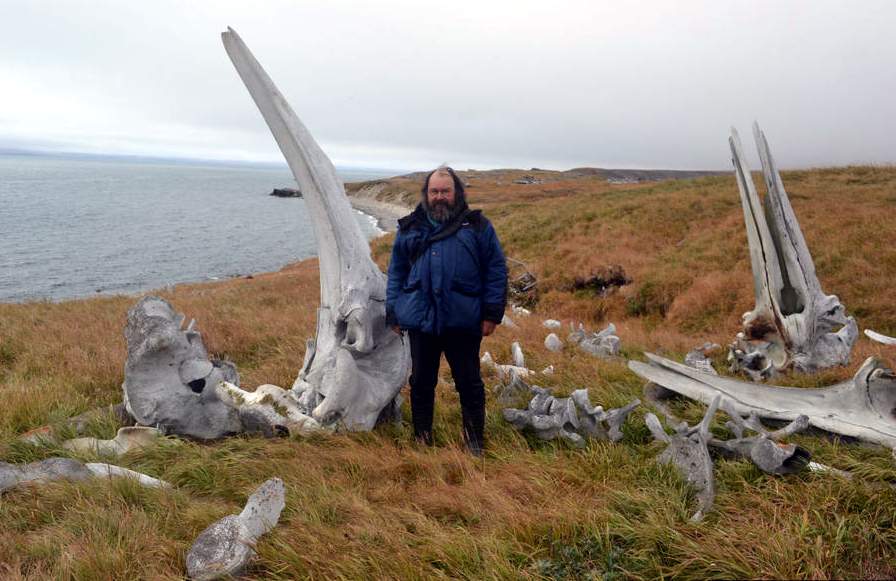
It is possible that the individual pillars and groups of pillars scattered along the Whale Avenue belong to the rest of the clans or villages. But in the structure of the avenue itself, it is as if the “social code” of the inter-village association, the personification of which it was, is recorded.
Among the meat pits, along the slope of a stone scree, there is a fairly smooth and paved road paved with stone — its construction, of course, required collective labor. It starts from the central dense cluster of pillars and ends at a fairly wide circular area surrounded by a ring of large stone blocks. A bright white stone is embedded in one edge of the ring, and under it is a trace of ash from the hearth. Obviously, there was the central sanctuary of the whole association, where common rites were sent by representatives of all the villages included in the union. If you look at the plan of the alley, then this sanctuary is located at the top of the pyramid, and it really is the highest point of the whole complex. And the base of the pyramid is a group of whale skulls that stretch along the coastline: there are about 15 such groups that are fairly standard, as if repeating each other. Probably, they represent one and a half dozen villages that were part of the local tribal alliance. Moreover, it is possible that this union was open for other villages to join it in the future.
And now the picture that was painted in our imagination, we can already call not a hunch, but a scientific reconstruction.
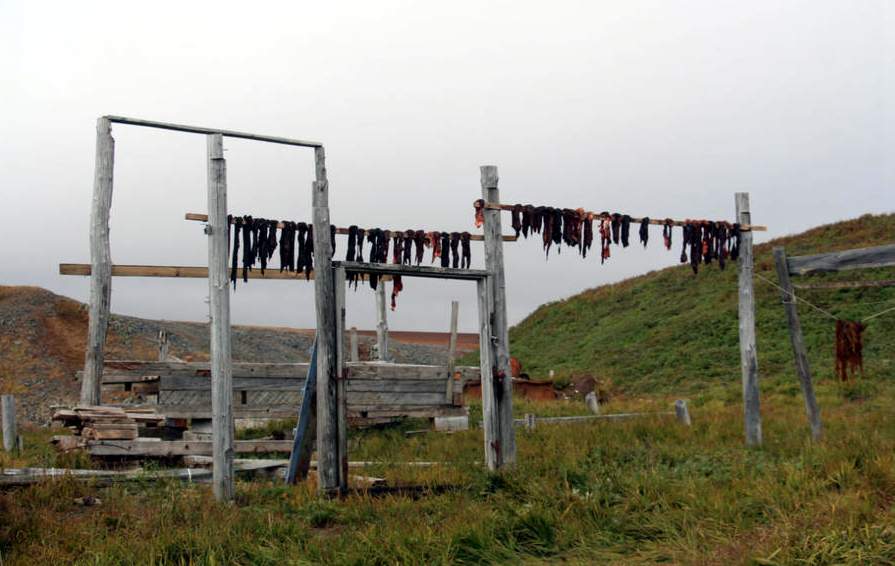
... The last one comes from Kigi. This year, the elders of Kigi received the right to be masters of a common holiday, they stockpiled meat from the spring hunt, having built three new large pits for it. And now they are following their canoe on the floats of a large whale skull. In memory of this day, they dig it in the moorage of the Kigi canoe, where there are already five such skulls, set in past years.
There will be a feast, there will be dances, competitions in dexterity and strength. Colorful figures of wood and feathers on whalebone leashes will decorate the pillars. But amid the fun, the leaders will find time to talk about serious and very unhappy things: in recent years, even less whales have been obtained, and more and more often the Siwukan raids, a once-friendly tribe, have to be repelled ... And the oldest and the experienced ones, perhaps, already feel the onset of such times, when the island union disintegrates, there will be no one to lay the meat in the stores at Siklyuka; and the rites, and the meaning of the sanctuary, and his very name will be forgotten ...
More than half a thousand years have passed since then, but the milestones indicating the way to the Whale Avenue still rise on the headlands of Arakamchechena. In some places, near them, automatic acetylene beacons stood, along which modern sailors are heading for different places and for completely different purposes. But the bones of the Whale Alley cannot leave us indifferent. They talk about the complex and rich history of everyone, even the farthest corner of our homeland, they talk about the action of universal historical laws that manifest themselves on any soil as soon as the productive forces of society reach a certain level.
(authors: S. Arutyunov, doctor of historical sciences; I. Krupnik, M. Chlenov, candidates of historical sciences)
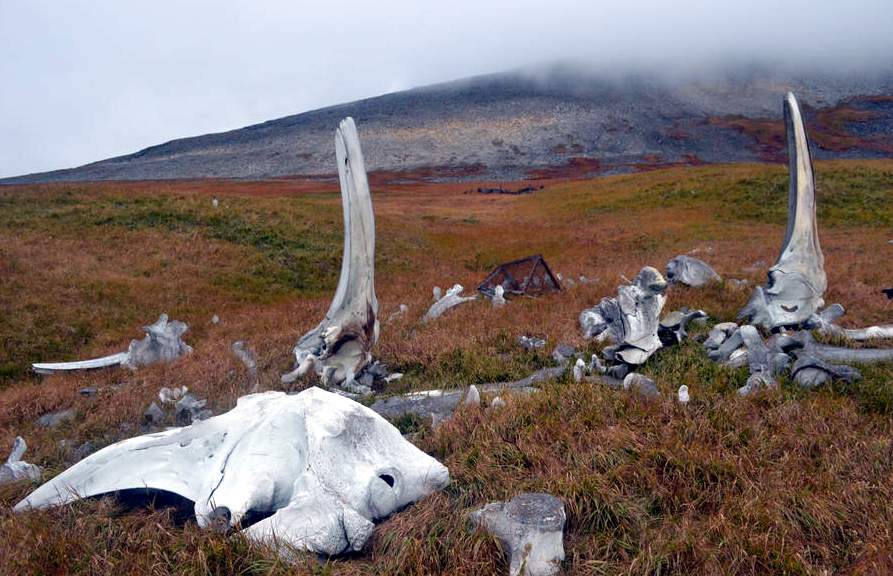
____________________________________________________________________________________
SOURCE OF INFORMATION AND PHOTO:
Team Nomads
http://www.vokrugsveta.ru/vs/article/5732/
http: //100 chudes.rf/
S. A. Arutyunov, I. I. Krupnik, M. A. Chlenov. "Whale Alley". Antiquities of the islands of the Senyavin Strait. 1982
V. V. Leontyev, K.A. Novikova. Toponymic Dictionary of the North-East of the USSR. - Magadan: Magadan Book Publishing House, 1989, p. 161.
http://www.photosight.ru
Mikhail Tsiporukha. Around the world under sail. - M: Veche, 2012. - ISBN 9785953362429.
A. A. Korobkov. The Red Book of Russia (1981).
Arutyunov S.L., Krupnik I.I., Chlenov M.A. 1982. “Whale Alley” (Antiquities of the Senyavin Strait Islands). M .: Science, 175 p.
http://s018.radikal.ru/
There is one amazing Chukotka island - Ittygranlocated in senyavin Strait Bering Sea. It is there that is the main architectural relic of the ancient Eskimo culture - Whale Alley, still concealing many secrets and mysteries. This unique cultural monument was found in the mid-70s of the last century by one of the expeditions sent there by the Institute of Ethnography of the USSR Academy of Sciences.
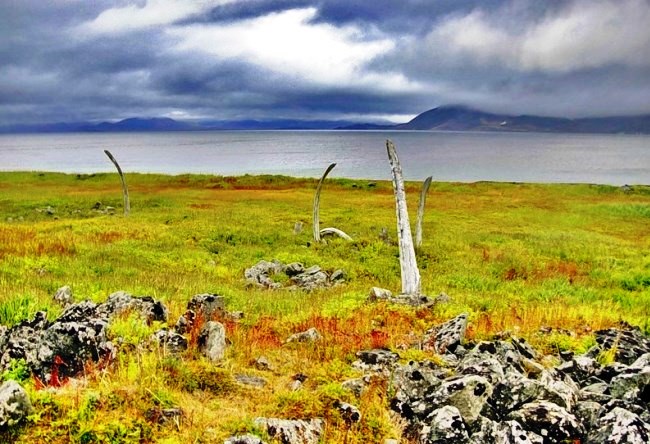
It was a successful, but almost accidental discovery, the grandeur of which is still striking: the northern coast of Ittigrana is set with huge whale bones dug into the ground in the form of two parallel rows stretching nearly five hundred meters. That part of the alley, which is located closer to the water, is made up of the bones of the whale's jaws, reaching a height of about five meters. The second row, located farther to the shore, consists of 15 segments, each of which consists of 2-4 two-meter whale skulls. In total, in order to build the entire composition, the bones needed 5-6 dozen adult bowhead whales, no less. Between the double bone "fence" scientists discovered " meat pits", In the amount of one and a half hundreds, which have retained traces of food. This testifies to the fact that large feasts were once held in this place.
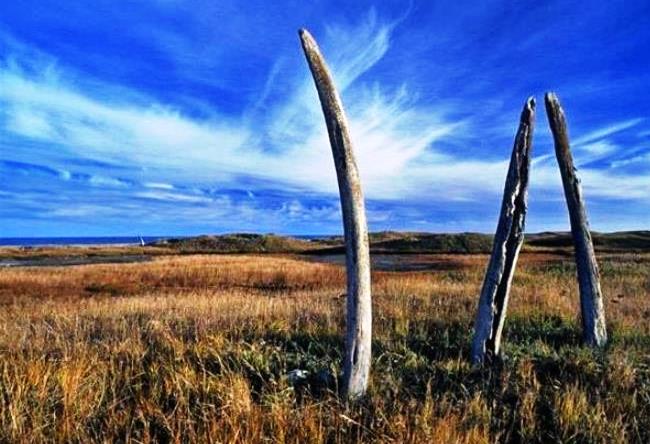
In addition to the “meat pits,” stone circles were found, in the religion of the indigenous people of the North that were directly related to death and burial. Next to the pits, a stone road was laid, stretching to a lined rounded place, which was surrounded by huge boulders. In the middle of the round platform lay a flat stone. Not far from the stone, they found a hearth of stone, preserved in pieces of ash. Scientists have concluded that this place was once considered the peoples who inhabited the southeastern coast of Chukotka, sacred, and it was also their cultural center. They rushed here to participate in religious or secular events. Here the sea spirits received gifts and prayers from people. There were competitions and tournaments for speed and endurance. And, perhaps, even initiated young community members.
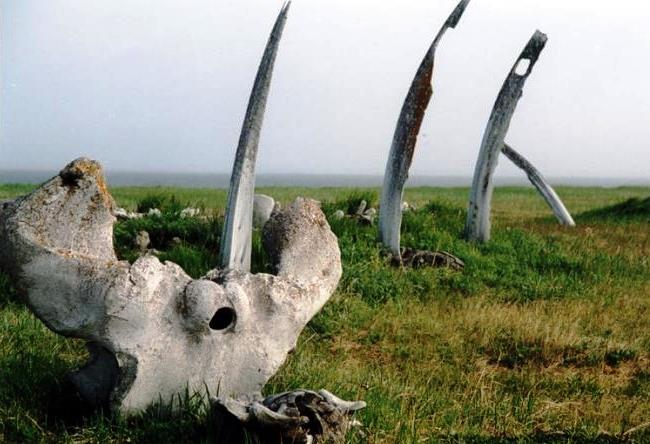
It is believed that all those who arrived on the peninsula could simultaneously take part in religious activities, since the objects of the cult are placed for this very convenient. However, only the wise men and the most successful hunters were invited to the site itself. It is believed that the creation of the Whale Alley falls on the 14th century. During this period, the peak of the culture of northern whale hunters. But perhaps it was built earlier. In the 16th century, the waters of the Bering Strait underwent a sharp cooling, whale waters almost left there, and hunting for them became rare. Over time, the true purpose of the bone alley was forgotten. New generations of Eskimos used it as targets for rifle shooting.
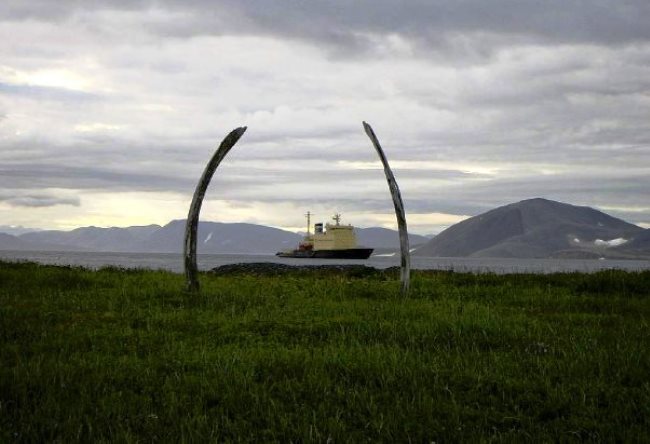
Sailors calling on the island also showed no respect for this structure. Sea level rose and contributed to its destruction. Earlier Whale Alley It was a much more majestic object, now some of the bones are fragments buried in the sand. In ancient Eskimos legends it is often said that Ittygran - a mysterious land, but this is not confirmed by anything concrete. Even the oldest of the inhabitants do not remember anything about it. It is no secret that whale bones, as well as stones and stone slabs were often used in the northern region as a building material. But there is nothing like this alley, neither within Chukotka, nor in the world at all. In this regard, Whale Alley is a unique cultural monument, about which so far little is known.
Additional Information
- Country Russia
- City: Chukotka
Whale Alley - An Ancient Eskimo Sanctuary on the island of Itygran (Chukotka), an archaeological complex consisting of two rows of huge bones of bowhead whales dug into the ground. The complex was opened in 1976 by a group of researchers from the Institute of Ethnography of the USSR Academy of Sciences under the guidance of M. A. Chlenov.
Northeast of Providence Bay, in the Bering Strait, on the island of Yttygran, there is a unique archaeological complex - Whale Avenue. Nowadays, the Whale Alley is one of the most famous sights of Chukotka, but until recently no one knew anything about it.
Let us turn again to the materials of the first scientific expedition that studied this unusual architectural structure. The monument was not accidentally named by researchers "Whale Alley". Its main components are two rows dug into the soil of the huge bones of bowhead whales. One row form the skull. Each of them reaches a width of at least two meters and rises one and a half meters above the ground. Fifteen groups of skulls are located along the coastline. (The builders of the Whale Alley used the remains of not less than 50-60 adults). The second row, which runs parallel to the first, consists of massive pillars of jaw bones. Their diameter is about half a meter and almost five meters is the height of each pillar.
In the space between the rows of skulls and jaw bones of the bowhead whale, there are stores for products — meat pits — and artificial structures in the form of rings lined with stone. At the end of the complex, a man-made stone road 50 meters long was preserved on the hillside. The road leads to a flat, round area. The site is surrounded on all sides by boulders. In the center of it also lies a large flat boulder, and not far from it there is a hearth made of small stones, filled with ash.
Studying the pebble spit, on which a significant part of the monument is located, the expedition participants turned their attention to the numerous whale bones lying under a thick layer of pebbles at the very edge of the surf - mainly the skull. In the past, they, undoubtedly, were also part of the Whale Avenue, and, thus, it was an even more ambitious complex than on the days when the first scientific research began on Yttygran.
The bones of whales, boulders and stone slabs have long been used by Arctic sea hunters in the construction of dwellings and outbuildingshowever, nothing like the Whale Avenue was found on Chukotka or outside of it. It is not only the size of the monument that amazes the imagination (its total length is 500 meters!), But also the structure of the architectural complex. Whale alley is unique in the truest sense of the word.
There is a very interesting sight in Chukotka - unusual and mysterious. It causes curiosity and amazement, not only among tourists who have visited here, but also for those who were lucky enough to just hear the story of eyewitnesses. This is the Whale Alley. In the Bering Strait to the northeast of Providence Bay on Ittigran Island is a creation of an ancient man, which is valuable both in historical and scientific terms. The place is remarkable for its pristine impregnable beauty - the slopes of the mountains, cliffs, rocky cliffs and hills alternate with each other, showing the beauty of these harsh places. The gently sloping areas covered by lush vegetation of the tundra. This bright background even more highlights the white remains of huge animals - the bones and jaws of whales. At first glance, it is not even clear that these snow-white pillars have a bone structure. However, with closer contemplation, the silhouettes of the skulls of marine mammals leave no doubt - these are the remains of whales. Their narrow front part protrudes into the pebbles, making the skull immobile.
There are no other parts of the skeleton on the coast. Only giant skulls, which, apparently, brought here already treated and cleansed of flesh. This creation was created by human hands - the only monument of the ancient Eskimo culture. The length of the complex of bones stretches for half a kilometer. It is believed that this place was a public center and a huge sanctuary in which residents of all Eskimo villages located in the east and south of the Chukotka Peninsula gathered. It is assumed that representatives of northern nations from St. Lawrence Island, which now belongs to the United States, came here. Between the skulls of animals are pits-storage. Inside they are lined with stones and have the shape of round wells. Products were stored here. The end of the building is crowned by an extensive fifty-meter road. Through it you can reach the flat stone platform round shape. It is surrounded by high smooth boulders. Another large stone is placed in the center, next to it is a hearth, also made of stones. Inside - the remains of ash.
The construction of bones and stones was found by researchers in 1976. At the site of the building there are no traces of the settlement. There is no direct connection with any one village. However, the scale of the construction suggests that a large group of people participated in the creation of the Whale Alley. Meat pits that are located in the sanctuary are usually used by the same family. How many homes - so many pits. On the territory of the sights they found about 150 pieces. For small northern peoples, this is a large number of families, since the largest village in Chukotka had about 50 people.
Local Eskimos completely ignore the structure, which causes confusion among scientists and researchers. True to their customs and deeply respecting the memory of their ancestors, they simply do not pay attention to the cult creation of powerful skulls. Researchers do not know where this building came from and why it appeared here. There are several versions. One thing is certain: the construction of this monument required tremendous efforts if only one bone is five meters long. According to scientists, it took about 50 bowhead whales to create the temple.
Even giving a local does not make the picture clearer. Some say that this place was an arena for shamans' competitions, others were a storehouse of products, while only a shaman could open a hole. The notes and holes in the bones suggest that there were competitions in agility and accuracy earlier. Perhaps this is how the selection went to the caste of hunters, which was considered the strongest and most privileged among the northern peoples. It is assumed that the whale temple was a kind of gathering place, where feasts were held and councils of the heads of communities of the north were held. Giant white skulls are clearly visible from the sea, perhaps they served as a kind of guide for hunters from distant places. It is believed that here the representatives of the northern peoples could unite and hold conversations, the purpose of which was to solve the problem, help and mutual assistance. This indicates a high level of social interaction and development of the Eskimos, which can not but arouse admiration. Instead of wars and attacks, they preferred to solve problems in a civilized way and act together.
White pillars of bones make a strong impression, which is akin to mystical. The landscape created by man reminds more of the scenery for a fantastic film. There are a lot more questions than answers, and you can build assumptions endlessly. However, one thing is for sure - the Whale Alley is another trace from the past, the voice of the ancient sages, who do not tire of reminding that modern man knows far from everything, and that the wisdom of the Earth lies in itself.
There are few places on earth like Whale Alley, unique in its kind (objects were built from animal bones before, but completely different). The shrine of the Eskimos, created in difficult northern conditions, looks extraordinarily like something unearthly.
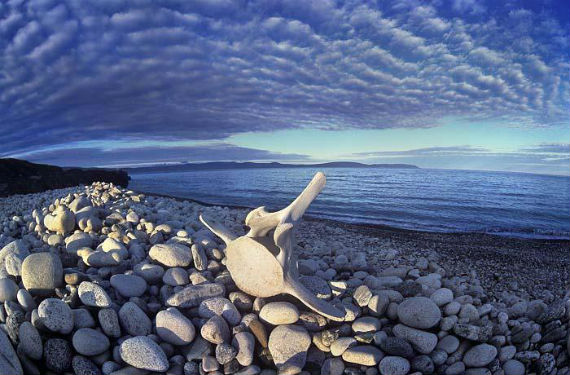
photo Yakovleva Z. M.
The Whale Alley is located in Chukotka, on the island with the difficult to pronounce name Itygran. It is an alley of symmetrically “planted” into the land bones of bowhead whales. Jaws and skulls were used as a building material (as the scientists calculated, in total, at least 50 adult whales took part in the dissected form).
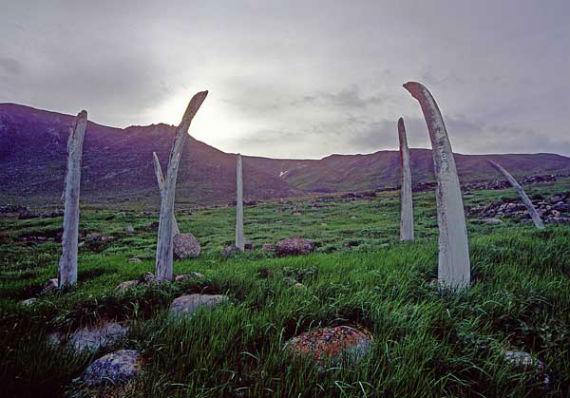
photo of Arkady Sukhonin
One can imagine how difficult the construction of the alley was, given that one bone is about 5 meters high. And some of them have holes of artificial origin. Since the skull and jaw bones are at some distance from each other, it was probably earlier that the walkway was more extensive than on the days when its research began. But from the preserved objects one can understand that the Whale Alley was created very precisely and accurately, possibly - according to a previously created plan.
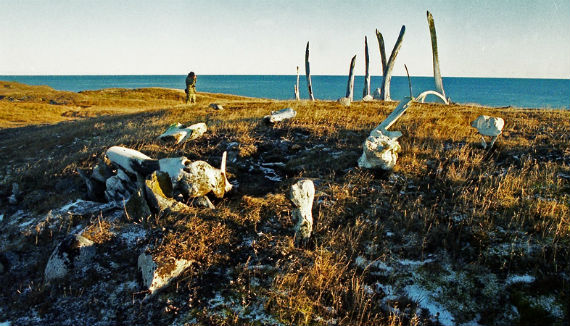
So, many centuries ago, the inhabitants of Chukotka tried their best to create their own sanctuary. A road paved with stones leads along it, which ends with a platform surrounded by large boulders with a hearth in the center. However, all these objects so far have not brought scientists closer to answering the main questions: who created the Whale Alley and why?
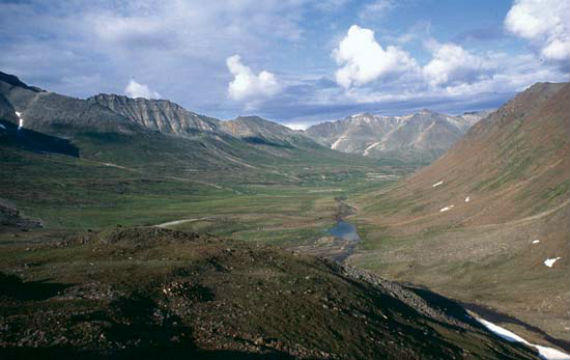
chukotka Peninsula
It is clear that she had a ritual meaning, but what kind of - more mystery. Even in the legends of local residents there is no clear answer. But if you turn to them, you can find out that the island was considered the main storage of meat, but in order to open the “meat pit” you need to be a shaman.
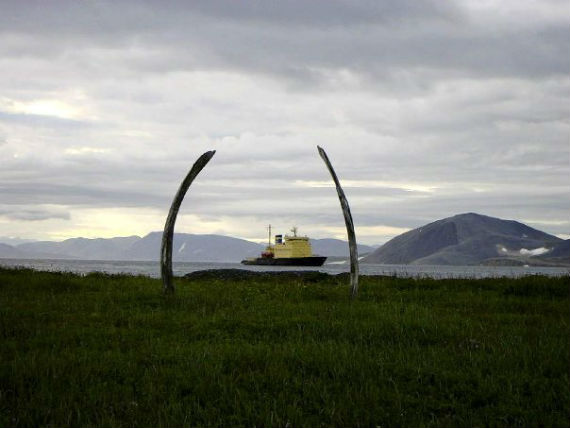
According to another version, the Whale Alley became the site of the battle of the “flying shamans”, but what this battle was and who won, history, alas, cannot answer.
Also, the Whale Alley is considered something of a local Colosseum - the holes mentioned above could serve to test the strength and dexterity of the hunters, possibly thus being selected for the privileged caste of miners.
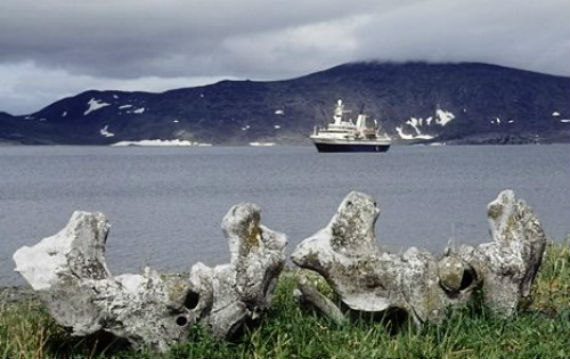
The whale alley had not only a religious, but also a completely utilitarian purpose - in some places between the bones there are remnants of economic pits, where the meat obtained during the hunt was kept. It should be noted that there really was a lot of it, and historians-anthropologists believe that not only shamans, but also all members of the tribes (male) feasted here.
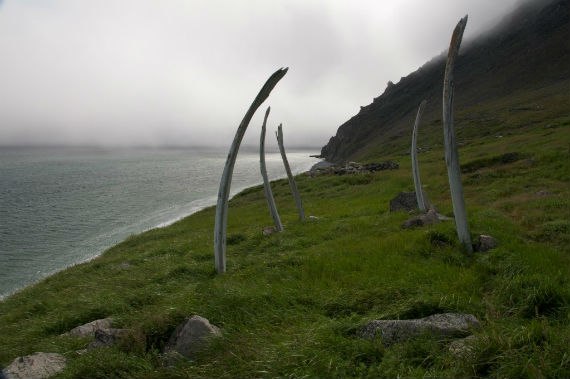
In addition, there is an opinion that the Whale Alley was both a repository, a sanctuary, and a sports field ... but the main thing was a meeting place for the participants of the first "trade unions" of whale hunters and fishermen in general. And stored skulls are considered marks for the berths of boats, so that representatives of these professions from different tribes can easily find their way, meet, discuss problems and conflicts, and then arrange a common feast.
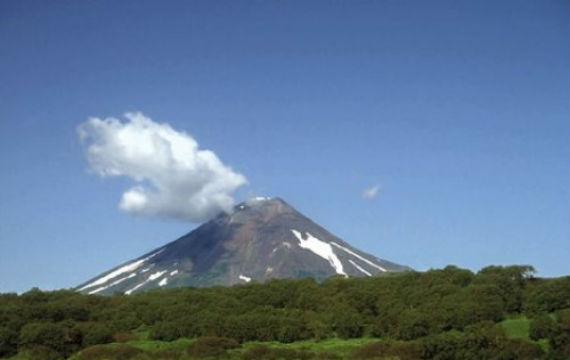
yttegran Island
In any case, the very fact of the existence of such an object as the Whale Alley indicates that the anecdotes about the Chukchi are nothing more than a stupid stereotype, because under difficult conditions they were able to create a rather complex infrastructure that is inherent in more advanced civilizations, and also make one of the main actions in the history of human development is to unite in order to survive, and not try to take the latter from the neighbors. So you can admire the Whale Alley, if only for the fact that it symbolizes the willingness to cooperate and mutual assistance, as well as "solving questions by talking, not by fists."
Anastasia Berseneva
Ksenia Krzhizhanovskaya
